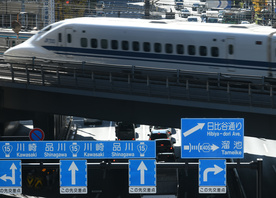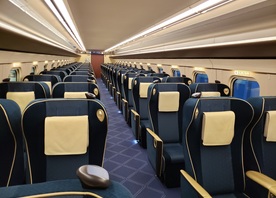Sit in comfort and enjoy travel along the Sanriku coastline with plenty of beautiful views along the way.
Legend has it that somewhere hidden in the north of Tohoku, in the remote prefecture of Iwate, there is a little train where all seats are Kotatsu seats. Operated by the local Sanriku Railway during winter, this train allows passengers to warm themselves up during travel and enjoy a little meal with ingredients that are typically found in the Sanriku area. Entertainers dressed as traditional Japanese mythological demons sometimes make an appearance on the train and put on a performance.
Before further exploring the train, let’s have a look into what a Kotatsu is and why they are such a brilliant invention.
What is a Kotatsu?
Historically, a Kotatsu (こたつ) is a Japanese low wooden table covered with a futon or heavy blanket, with a heating source below the table. Formerly this was done with a charcoal brazier, and at present with an electric heating source. Typically, they are used during winter and make for a great opportunity to sit together with friends, family and loved ones. In a recent poll, 81% of households in Japan admitted to having at least one Kotatsu.

Interestingly, Kotatsu are unique to Japan and anyone that has spent a winter in Japan will know how comfortable they are. Yet the concept remains relatively unknown outside the country. That makes for an even better excuse to try one and understand a tiny bit more about Japanese culture.
As it is customary to sit on the ground in a Japanese house, Kotatsu can be used without additional seats. Yet to make things even more comfortable, special Kotatsu seats are available. These are typically chairs with plenty of back cover but without any legs.
Inside the Kotatsu train
The train itself is quite small with only two train wagons, with a layout of 12 Kotatsu tables (each with 4 seats). The interior has an old style wooden design, to resemble the snugness of an old Japanese countryside home. On-board drinks and food are served, at a small fee.

Photo (c) Sanriku Tetsudo
The views from the train are scenic, the Sanriku coast is made of rough stone formations and dark volcanic soil overlooking the Pacific Ocean.

Route and fare information
The Kotatsu train travels between Kuji station <-> Miyako station, in addition between Sakari station <-> Kamaishi station.
Fares depend on distance travelled and are the same as local train fares. They start as low as 300yen and as high as 2.000yen for the entire route. As the train is not operated by JR-East, no rail passes are accepted. However, very good saving can be had using a pass traveling to the Sanriku area. More about that below.
Access to the Sanriku Railway and using the JR Pass
The Sanriku Railway connects to JR lines at the following stations: Kamaishi (connecting the Kmaishi Line), Miyako (connecting to Yamada Line), Fuji (connecting to Hachinohe line).
The easiest way to access the area is to use the Tohoku Shinkansen from Tokyo up north and use a local JR line to connect to the Sanriku Railway. The fastest option is to use the Hokuriku Shinkansen to Morioka station, then transfer to a local service bound for Kamaishi. The JR Fare for this route is ¥17,780 and fully covered by the Japan Rail Pass and JR East Tohoku passes.
Alternatively, Kuji station can be reached by using the Tohoku Shinkansen to Hachinohe station, followed by a local train ride. With a fare of ¥17,140, also entirely covered by the Japan Rail Pass or any applicable JR East pass.
For more information see: Sanriku Tetsudo website.

.png)



